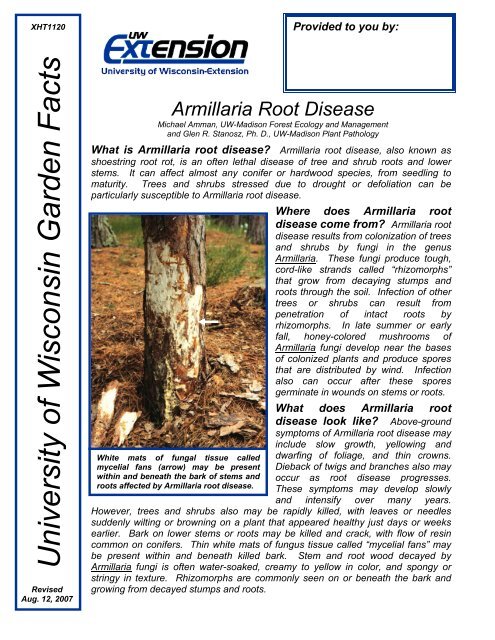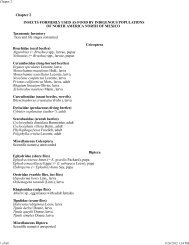Armillaria Root Disease - Wisconsin Horticulture - University of ...
Armillaria Root Disease - Wisconsin Horticulture - University of ...
Armillaria Root Disease - Wisconsin Horticulture - University of ...
Create successful ePaper yourself
Turn your PDF publications into a flip-book with our unique Google optimized e-Paper software.
XHT1120Provided to you by:<strong>University</strong> <strong>of</strong> <strong>Wisconsin</strong> Garden FactsRevisedAug. 12, 2007<strong>Armillaria</strong> <strong>Root</strong> <strong>Disease</strong>Michael Amman, UW-Madison Forest Ecology and Managementand Glen R. Stanosz, Ph. D., UW-Madison Plant PathologyWhat is <strong>Armillaria</strong> root disease? <strong>Armillaria</strong> root disease, also known asshoestring root rot, is an <strong>of</strong>ten lethal disease <strong>of</strong> tree and shrub roots and lowerstems. It can affect almost any conifer or hardwood species, from seedling tomaturity. Trees and shrubs stressed due to drought or defoliation can beparticularly susceptible to <strong>Armillaria</strong> root disease.White mats <strong>of</strong> fungal tissue calledmycelial fans (arrow) may be presentwithin and beneath the bark <strong>of</strong> stems androots affected by <strong>Armillaria</strong> root disease.Where does <strong>Armillaria</strong> rootdisease come from? <strong>Armillaria</strong> rootdisease results from colonization <strong>of</strong> treesand shrubs by fungi in the genus<strong>Armillaria</strong>. These fungi produce tough,cord-like strands called “rhizomorphs”that grow from decaying stumps androots through the soil. Infection <strong>of</strong> othertrees or shrubs can result frompenetration <strong>of</strong> intact roots byrhizomorphs. In late summer or earlyfall, honey-colored mushrooms <strong>of</strong><strong>Armillaria</strong> fungi develop near the bases<strong>of</strong> colonized plants and produce sporesthat are distributed by wind. Infectionalso can occur after these sporesgerminate in wounds on stems or roots.What does <strong>Armillaria</strong> rootdisease look like? Above-groundsymptoms <strong>of</strong> <strong>Armillaria</strong> root disease mayinclude slow growth, yellowing anddwarfing <strong>of</strong> foliage, and thin crowns.Dieback <strong>of</strong> twigs and branches also mayoccur as root disease progresses.These symptoms may develop slowlyand intensify over many years.However, trees and shrubs also may be rapidly killed, with leaves or needlessuddenly wilting or browning on a plant that appeared healthy just days or weeksearlier. Bark on lower stems or roots may be killed and crack, with flow <strong>of</strong> resincommon on conifers. Thin white mats <strong>of</strong> fungus tissue called “mycelial fans” maybe present within and beneath killed bark. Stem and root wood decayed by<strong>Armillaria</strong> fungi is <strong>of</strong>ten water-soaked, creamy to yellow in color, and spongy orstringy in texture. Rhizomorphs are commonly seen on or beneath the bark andgrowing from decayed stumps and roots.
<strong>University</strong> <strong>of</strong> <strong>Wisconsin</strong> Garden FactsCan I save a tree affected by <strong>Armillaria</strong> root disease? There is nopractical way to eliminate <strong>Armillaria</strong> from trees that are already colonized by thefungus. The useful life <strong>of</strong> an affected tree might be prolonged, however, bysupplemental watering during dry periods and appropriate fertilization to improveoverall host condition. In very vigorous trees, the pathogen may be “walled <strong>of</strong>f” andconfined to just a portion <strong>of</strong> the root system or root collar. There are no chemicaltreatments that can effectively target the <strong>Armillaria</strong> fungi within diseased trees.How do I avoid <strong>Armillaria</strong> root disease in the future? Practices thatmaintain trees in vigorous condition are the best means <strong>of</strong> preventing <strong>Armillaria</strong> rootdisease. Watering and fertilization to avoid stress will help trees resist infection.Because <strong>Armillaria</strong> root disease <strong>of</strong>ten develops in response to defoliation,suppression <strong>of</strong> both insect and leaf pathogen defoliators will indirectly reduce theoccurrence and severity <strong>of</strong> <strong>Armillaria</strong> root disease. Because stumps and rootsystems <strong>of</strong> previously colonized trees can serve as “food bases” supportingrhizomorph growth for many years, thorough removal will reduce the risk <strong>of</strong> infection<strong>of</strong> other trees.For more information on <strong>Armillaria</strong> root disease: Contact your countyExtension agent.© 2002 by Glen R. Stanosz, all rights reserved.An EEO/Affirmative Action employer, <strong>University</strong> <strong>of</strong> <strong>Wisconsin</strong>-Madison provides equal opportunities in employment and programming, including Title IX and ADA requirements. This document can beprovided in an alternative format by calling Brian Hudelson at (608) 262-2863 (711 for <strong>Wisconsin</strong> Relay).References to pesticide products in this publication are for your convenience and are not an endorsement or criticism <strong>of</strong> one product over similar products. You are responsible for using pesticidesaccording to the manufacturer’s current label directions. Follow directions exactly to protect the environment and people from pesticide exposure. Failure to do so violates the law.Thanks to Ann Joy and Brian Hudelson for reviewing this document.A complete inventory <strong>of</strong> <strong>University</strong> <strong>of</strong> <strong>Wisconsin</strong> Garden Facts is available at the <strong>University</strong> <strong>of</strong> <strong>Wisconsin</strong>-Extension <strong>Horticulture</strong> website: wihort.uwex.edu.
















